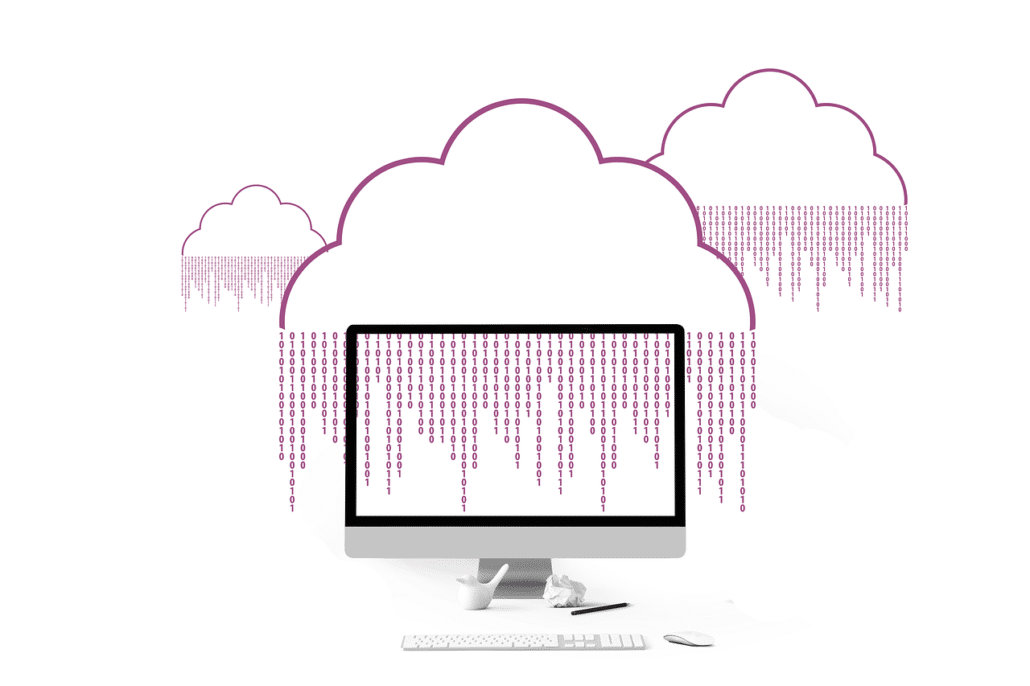Private Cloud vs. Public Cloud
Data is moving to the cloud at an incredible pace.
Gartner estimates that over 95% of new digital workloads will be deployed on cloud-native platforms, up from 30% in 2021.

Perhaps the biggest reason for this explosion of the cloud is the arrival of the age of digital transformation. 63% of companies say that they’re moving to the cloud to support their digital transformation campaigns this year.
However, another 66% of IT professionals believe that security is the most significant concern they’ll need to face when choosing the right cloud environment.
After all, cloud-based solutions don’t just come in a single format. According to the LogicMonitor Cloud Vision study for 2020, approximately 41% of enterprise workloads will be run on public cloud platforms, thanks in part to their accessibility and affordability.
However, a growing number of companies are also considering private cloud (20%) and even hybrid deployments (22%) to protect their data.
Cloud-based solutions in the modern enterprise aren’t just about accessing higher bandwidth and dependability.
The right service can also give companies an essential level of control when it comes to managing highly sensitive data.
The level of control that you have over that information, and the opportunities available to protect it will depend on the kind of cloud you invest in.
Read on for your full guide to private cloud vs. public cloud in the digital landscape.
Contents
- Public Cloud vs. Private Cloud: Defining the Two Options
- The Main Differences of private cloud vs. public cloud
- Critical Characteristics of Public Cloud:
- Critical Characteristics of Private cloud:
- The Benefits of Public Cloud Computing
- The Problems with Public Cloud Computing
- On-Premise Private Cloud Computing Benefits
- The Problems with On-Premise Private Cloud Computing
- The Benefits of a Hosted Private Cloud Environment
- What is Hybrid Cloud Computing?
- Problems with the Hybrid Cloud
- How Secure is Cloud Storage in General?
- Choosing your cloud solution
Public Cloud vs. Private Cloud: Defining the Two Options
Public cloud storage and private cloud are the two primary options available for today’s businesses. Both give companies the opportunity to access novel technologies in the digital landscape.
In the era of digital transformation, cloud computing opens doors to things like DevOps agility, mobility, artificial intelligence, and machine learning. The cloud environment also enables machines to communicate effectively through IoT connectivity.
The public cloud is currently the most popular form of cloud.
It refers to environments that are available via a publicly accessible portal. Some public cloud storage solutions are possible over a web-page, while other solutions require you to install proprietary software to your machine.
- Any user can request access to the same infrastructure, and a variety of companies share the same infrastructure.
- This makes the public cloud is far more affordable and flexible for smaller companies.
- In the public cloud environment, the storage platform is hosted by a third-party provided – delivered and managed over the internet.
- There are no capital expenses to worry about, and users can handle their fees through predictable monthly payments.
- The storage and processor power required to run the cloud tools are not managed by your business, so there’s less need for IT expertise.
The biggest problem with the public cloud is security and resiliency. Although public cloud environments are secure, sharing resources with others means you cannot get tailored security solutions for your own part of the cloud.

Now that 85% of enterprises are keeping sensitive data in the cloud, private solutions are becoming increasingly more appealing – particularly for companies in highly-regulated industries.
Private cloud deployments deliver computing resources that are uniquely tied to a specific user.
All of your critical information is stored within a network of privately dedicated resources.
Many people see this option as a chance to extend their pre-existing data center, with additional storage capacity and processing power.
Although there’s more demand on your resources to specify and maintain your new cloud infrastructure, there’s also a lot more control available through a private cloud.
A private cloud can also be a problem for many companies, as the infrastructure and deployments are managed on your end. This means that you need to ensure that your security systems are always up-to-date – the vendor won’t do it for you.
Private clouds are also more flexible than the public cloud, with customization options available for specific regulations and demands.
The Main Differences of private cloud vs. public cloud
Before we cover the unique benefits associated with both private and public cloud, let’s examine how the two options differ from each other in closer detail.
Importantly, both cloud computing solutions are growing increasingly popular.
According to IDC, cloud computing spending is expected to see a growth rate that’s 6 times higher than standard IT spending through 2020.
Whichever option you choose, you’ll be part of a growing revolution on the cloud.
Critical Characteristics of Public Cloud:
- Billed according to usage: You can access pay-as-you-go public cloud offerings that bill you based on the number of minutes you use within individual pieces of computing equipment.
- Hosted at the vendor’s facility: You won’t need to purchase, manage, deploy, or maintain your computing infrastructure at a physical building.
- Shared hardware: You will be using the same shared physical server and storage appliances as many other companies working with the same vendor.
- Fast scaling and provisioning: it’s easy to establish a new server and additional bandwidth in the public cloud whenever you need more space.
Critical Characteristics of Private cloud:
- Hosted on-premise: Most private cloud solutions from a traditional vendor require businesses to purchase, manage, and maintain their own hardware.
- Higher capital expenses: There may be numerous up-front costs associated with deploying the required infrastructure for a private cloud environment.
- Limited scalability: For many users, a private cloud won’t offer a great deal of scalability, as you’ll need to buy additional infrastructure to extend your services. However, it is more flexible than a public cloud.
- Dedicated hardware: You get the benefit of knowing that you’re the only company with access to the cloud resources that you’re using.
Some companies are also beginning to offer hosted private cloud solutions, which are much more beneficial than the traditional on-premise private cloud.
These share many of the characteristics of a public cloud, including high scalability and the ability to host your environment at a vendor’s facility. Additionally, like with public cloud investments, there are variable billing options available that allow you to spend money as and when you choose.
Hosted private cloud solutions can be far easier to access and use. Although you still get dedicated software and hardware that means that your information can be kept secure – you’re not deploying and using that hardware on-premise yourself.
Hosted private cloud options are a good combination of both public scalability and private resilience.
The Benefits of Public Cloud Computing
Public cloud environments are available to anyone, which means that they can be an excellent solution for smaller brands and companies in need of budget-friendly storage solutions.
Cloud computing packages are operated by vendors with massive data centers. These data centers can distribute computing and storage resources across a variety of customers from different locations.

Perhaps one of the biggest benefits of public cloud computing is how easy it is to access. Because maintaining and securing infrastructure is the responsibility of the vendor – not the business, even smaller companies can streamline their IT operations this way.
Additionally, if your business is growing dynamically, you’ll have no problem scaling your cloud resources up and down according to your requirements. 36% of companies say that reducing the burden on IT staff is a crucial component of cloud computing. Public clouds can help with this goal.
Public cloud computing delivers:
- Agility: Often, when most enterprises are asked to provide a reason for choosing public cloud over provide connectivity, they put dexterity first.
Public clouds ensure that companies can provision and deploy new resources in real-time. This means that it’s much easier to achieve rapid time-to-market and keep costs low.
- Availability: Although there can be outages with any kind of cloud computing, the public cloud is still a lot more reliable than keeping your data and information on-premise.
Public cloud offers a great deal more uptime than most traditional data centers. Enterprises can even choose to access their services from a company that provides a guarantee for uptime.
- Scalability: As the need for an application or system grows, it’s straightforward for your business to add additional computing resources to suit demand. Most public cloud services will include some automated scaling so that businesses don’t have to worry about adding other computing resources at specific times in their growth cycle.
- Performance: In cases where organizations need access to high-performing computing resources for their workloads, the public cloud makes it much easier to access these capabilities.
You’ll only pay for what you use, which means that you can manage your expenses on a pay-as-you-go basis. You may even be able to access the latest technology in a public cloud data center without having to pay extra for new innovations.
- Location independence: It’s possible to access public cloud services wherever you are, using any internet-connected device.
This ensures that you’ll be able to deliver greater mobility to your workforce and expand your business overseas if you want to.
- Low costs: Because the costs of running a vast data center are spread across multiple people in a public cloud environment, the prices are often quite small.
This means that you don’t need to have to pay as much on your cloud infrastructure, and you can reduce costs in other ways too. For instance, many public cloud users can eliminate the need for specialist IT staff required to provision and manage servers and bandwidth on the back-end.
The public cloud also converts some capital expenses associated with one-time purchases of hardware and software into simpler operational costs.
The Problems with Public Cloud Computing
As compelling as public cloud computing can be in the right circumstances, it’s not always the right solutions for today’s businesses. The biggest disadvantage of the public cloud generally relates to concerns about security and control.
With public cloud computing, you rely on the vendor to keep you safe. This means giving up control over the physical hardware that stores your data and the solutions that keep your applications running. It’s also more challenging to know for sure whether your information is being appropriately protected on the back-end or not.
Because the public cloud environment is so vast and spread across multiple organizations, this also makes them a frequent target for hackers.
The chances are you’ve seen countless news stories about groups that have been able to break through into public cloud environments.
Some enterprises will also be concerned about the shared space that they can access on a public cloud. With the public cloud, workloads from numerous organizations are running within the same physical server.
Public cloud storage is often proprietary – meaning if your firm ever wants to migrate away from a cloud storage provider they may find it’s quite expensive and complex.
The other big problem with public cloud environments is the fact that they’re often not compliant with specific laws and regulations that are critical for certain industries. In the US, healthcare providers and financial service providers need to meet with very specific requirements when it comes to how they store and manage customer information.
Not all cloud providers will fit the requirements in these areas. Additionally, in Europe, sensitive information gathering and processing is much stricter since they adopted GDPR, and no matter whether you are based, you need to be compliant with this regulation if you wish to obtain and process data from EU subjects.
Not all public cloud environments meet these data sovereignty requirements.
Even the cost benefits of the public cloud can be problematic at times. Although the pay-per-use option will appeal to some companies, if your usage in a particular application suddenly skyrockets, there’s a risk that you could be left with a huge bill.
On-Premise Private Cloud Computing Benefits
The public cloud has its advantages for smaller companies and those who have fewer concerns to think about when it comes to addressing compliance.
There are some environments where a public cloud doesn’t make sense.
That’s why private cloud solutions were designed to support those with a need for higher security, resilience, and control.
As mentioned above, the private cloud is a computing environment that’s built and reserved for one specific enterprise to use. In a private cloud, every appliance and service is only available to one organization.
The benefits and issues with the private cloud depend on how you choose to access it. There are two distinct versions of the private cloud:
- Self-managed: You build your cloud environment with hardware and data centers that are managed by your own team.
- Hosted: Some vendors provide hosted private clouds, where someone else hosts and manages your cloud computing resources – similar to the experience you get with the public cloud. However, the servers are not shared among customers.
The benefits of a self-managed private cloud are:
- Greater security and control: This is the most prominent reason that companies generally choose a private cloud over a public option. With an in-house cloud environment, organizations are able to retain control over their infrastructure, which means that they can deploy security measures that have been chosen by their team. It’s possible to create a best-in-class environment that’s specifically suited to the needs of your business and industry.
- Improved compliance: With in-house private cloud environments, organizations also get the option to make sure that all of their data storage solutions comply with the regulations that are relevant to their industry. There’s complete control over all security measures here, and it’s easy to make sure that data remains within a specific geographic area too.
- Customization: An in-house private cloud will also provide enterprises with the ability to choose which hardware they’re going to use to store their data and run their applications. Like with a private cloud, it’s possible to access this environment from any location, using any internet-connected device.
- Agility and scalability: There are plenty of options for growth with a private cloud environment. You’ll be able to build out and extend your cloud however you see fit.
- Predictable costs: While the private cloud can be more expensive than the public cloud, the prices are far more predictable and more comfortable to account for. You’ll know exactly how much you’re going to be spending from one month to the next.
The Problems with On-Premise Private Cloud Computing
While private cloud computing is more secure and easier to control than public cloud solutions, there are some downsides to this option too.
In the case of on-premise private cloud computing, for instance, because organizations are required to manage and purchase their infrastructure, private cloud solutions are often costly.
You’ll need to pay for professionals to manage your cloud infrastructure on the back-end too.
Additionally, with a private cloud, companies need to handle all of the standard in-house services that would be managed by a public cloud vendor on the other side of the coin.
This means that deploying, provisioning, and monitoring hardware is much more difficult.

If you do decide to scale your cloud solutions in a private cloud infrastructure that’s on-premise, that also means investing extra time and resources into the process.
Acquiring additional resources and adding them to your cloud can be a very expensive and exhausting process.
In some instances, you may find that it’s difficult to access the latest cloud solutions on a private cloud environment too.
After all, you won’t be able to simply tap into the tools that your cloud vendor invests in. You’ll be required to purchase your own additional systems and innovations if and when you need them.
The Benefits of a Hosted Private Cloud Environment
Hosted cloud provider solutions were designed to overcome many of the issues that are common with on-premise private deployments.
These solutions are intended to give businesses access to the security and control benefits that they can get from the private cloud. Most of them will offer scalability and accessibility that’s common with public cloud environments too.
Like a public cloud, the hosted private cloud comes with the option to store your databases and required infrastructure on the vendor’s site, so that you don’t need to invest in or manage your infrastructure yourself.
Hosted private cloud offers a combination of what you get from the public and the private cloud.
Because only one company has access to the physical hardware and applications on the hosted private cloud, this eliminates many of the security and control concerns associated with the public cloud.
The only downside security-wise is that you still won’t have physical control over your servers – however, this might not be a problem if you know that your private provider is compliant with your industry’s needs.
Additionally, giving up control of your hardware means that you also get a more simplified management solution for your private cloud.
If you can find a hosted provider that you’re comfortable with, you won’t need to pay for a new IT team to manage and provision your physical hardware. Just like in the public cloud, your vendor will handle this side of the work for you, reducing the need for monitoring and maintaining complex tools.
Even though you don’t have complete control over the hardware, some vendors will also give you the option to customize your operations by specifying what kind of equipment is used to power your private cloud.
Another point to note with the private cloud is that the costs of this investment often remain highly predictable. Hosted private cloud models can vary. In general, you’ll be asked to sign a contract that specifies the amount of bandwidth you can use. This makes costs much easier to manage and a lot more predictable than with many public cloud offerings.
Although, some hosted private cloud providers will still increase costs if your usage starts to rise.
Like with the public and private on-premise cloud, hosted private clouds also come with additional agility, scalability, and availability compared to the conventional data center and computing strategies.
You’ll be able to build on your infrastructure quickly and efficiently as your business continues to evolve, ensuring that you always have access to the tools that you need.
What is Hybrid Cloud Computing?
Up until this point, we’ve discussed two of the most common cloud computing models: public and private environments.
As the technology landscape has continued to expand and evolve, we’ve also seen the arrival of another solution for growing enterprises: hybrid cloud.
74% of enterprises have said that they’re beginning to explore multi-cloud and hybrid cloud environments so far, hoping to gain some of the positives of both the public and private cloud environment.
Hybrid clouds combine multiple public and private cloud solutions, that are managed as part of a complete single entity.
This unique arrangement allows businesses to overcome some of the drawbacks of both private and public clouds and create their own unique environments instead.
For instance, companies with specific compliance requirements to consider could store more sensitive data in a secure private cloud.

They could still access data from an application that’s running in a low-cost public cloud too.
Companies could also choose to run most of their eCommerce and sales operations from the private cloud to ensure that the customer data stays secure. They’d also be able to scale up to public cloud environments at times when they need extra functionality.
Benefits of the hybrid cloud environment include:
- Enhanced flexibility: A hybrid cloud allows organizations to use the private setting for workloads and requirements that would be best served by a situation that they can completely control.
At the same time, the company can also use public clouds in times when it makes the most sense. There’s no need to choose between two options, users can instead access the cloud that simply makes the most sense.
- Security and compliance: Hybrid clouds can provide multiple forms of data security solutions when provided by the right vendor.
You can store customer credit card numbers and payments data in the private cloud – to ensure that there’s less access to outside sources.
At the same time, you can store public-facing web content in a slightly less-secure public cloud. This makes meeting compliance requirements a lot easier and more affordable.
- Improved scalability, agility, and availability: Because hybrid environments connect both public and private clouds, they offer the same kind of accessibility, agility, and scalability you would get with a public cloud, in an environment that’s as secure as you need it to be.
Additionally, as with any cloud, you can still access your applications and data from any environment or device that you choose.
Problems with the Hybrid Cloud
According to data presented at the AWS Summit, 65% of companies have a hybrid cloud strategy today.
Although the hybrid cloud was intended to overcome all the issues associated with both the public and the private cloud – it still has its negative points.
- The biggest downside is how complicated it can be to manage. Organizations often need to invest in special automation and other tool solutions if they’re going to manage different kinds of cloud in one environment.
- Enterprises will also need to invest in making sure that their staff has the right training required to manage, integrate, and monitor a secure hybrid cloud environment.
It’s a significant challenge to do this in many situations – and a problem that might be difficult to overcome for smaller businesses.
One point to note is that because the hybrid cloud also uses some public services, organizations face the risk of having to deal with surprisingly high bills resulting from periods of excessive usage.
Some companies believe that the unpredictability of the costs is often outweighed by the financial benefits of using the public cloud for certain operations.
The key to success with hybrid cloud environments, as with most cloud solutions, is making sure that you research your options carefully. Choosing the perfect cloud solution means looking at all of the solutions on the market and finding the one that’s best suited to your needs.
How Secure is Cloud Storage in General?
Before you decide whether cloud storage is the right solution for you, either in a public, private, or hybrid environment, it’s important to make sure you can see the benefits of this solution.
All files stored on a secure cloud server can benefit from an enhanced and more reliable level of security than you would be able to access a basic on-premise storage environment.
When choosing your provider, look for the following:
- Advanced firewalls: These firewalls inspect traveling data packets: Simple options will only examine the source and destination data, while advanced options verify the integrity of content packets. These programs also map packet contents to security threats.
- Intrusion detection: Cloud online storage can identify when someone is attempting to break into your systems, sending real-time notifications to business leaders to help you avoid problematic attacks.
- Event logging: Most cloud storage solutions also come with access to event logs that help security analysts to better understand the threats you face on a regular basis. These logs record network actions and help you to predict and prevent attacks in the future.
- Internal firewalls: All accounts shouldn’t always have access to all the data you have in the cloud. Limiting cloud access through internal firewalls can boost your security levels significantly.
- Encryption: Cloud security solutions come with the option to encrypt data both at rest and in-transit. This keeps your information safe from unauthorized users. If an attacker steals a file, they still won’t be able to read your data without an encryption key.
- Enhanced physical security: Many cloud data centers are very secure. Certified data centers come with 24-hour monitoring facilities and even armed guards. These places are far more secure than most traditional on-site data centers.
Choosing your cloud solution
The key to a successful choice between private cloud vs. public cloud is making sure you recognize the specific needs of your business.
Consider your privacy concerns and the regulations that you need to comply with in your industry. If your organization handles things like medical records and credit card information, there’s a chance that even the most robust public cloud won’t be suitable for you.
The more research you do into your available cloud environments, the easier it will be for you to take advantage of all the benefits the cloud has to offer while avoiding unnecessary risks.

